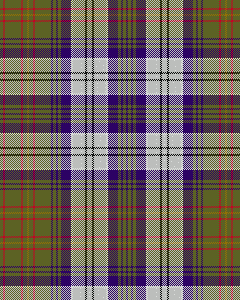-
- The O’Sullivan MacCragh Sept is an ancient family. It is universally agreed upon, by all credible annalists and historians, that it represents the most senior bloodline of the Gaelic families. The royal family of the Gaelic Celts in Ireland was known as the Eoghanacht (pronounced Owen-noct), the descendants of Eoghan (pronounced Owen). The most senior branch of the Eoghanacht was the O’Sullivan clan. The O’Sullivan MacCragh, in turn, was the most senior sept of this illustrious family. The significance of this can only be appreciated by comparing the status of the old Irish aristocracy with that of the rest of Europe. If the Irish had followed the English system of royal descent by primogeniture, and if Ireland had maintained its independence from England, an O’Sullivan MacCragh would be king of Ireland today.
|
 |
| The O'Sullivan MacCragh Tartan |
|
|
In June, 1994, Gary Brian O’Sullivan [121G] commissioned the O’Sullivan MacCragh tartan to be designed by Chris Aitken of Geoffrey (Tailor) High-land Crafts Ltd.
Tartans originated in Ireland, and were later introduced to Scotland by the Irish Celts. The earliest tartans were a type of shirt that ended just above the knee, known as the léine in Irish Gaelic. It was made of linen, and dyed a dark yellow shade, which led the English to describe it as “a saffron shirt”. In later times, stripes of various colors were incorporated into the léine to indicate the rank of the wearer. The High King was allowed to have seven stripes in his tartan, one of which was purple or dark blue, the color of royalty, and another, gold, the color of the sun. The Ollamh, or chief man of learning, was permitted to wear six colors on his tartan, demonstrating the high regard that the ancient Celts had for scholarship and learning. Eventually, a plaid pattern was adopted which resembled the modern day tartans that are so plentiful today.
In recognition of the royal blood of the O’Sullivan MacCragh sept, the clan tartan incorporates seven colors: blue, gold, black, silver, green, red, and white
The blue and gold stripes represent the senior branch of the clan, the descendants of Cragh, the O’Sullivan Mor. The black and silver threads represent the brave O’Sullivan Beara sept, famous for their march to the castle of O’Rourke in 1603. The green threads symbolize Ireland, the promised land of the Milesian Celts. The red threads signify the royal blood line of the O’Sullivan clan. The white threads represent the secret of the Magi, and its significance to the Gaelic over-lords of Ireland.
|